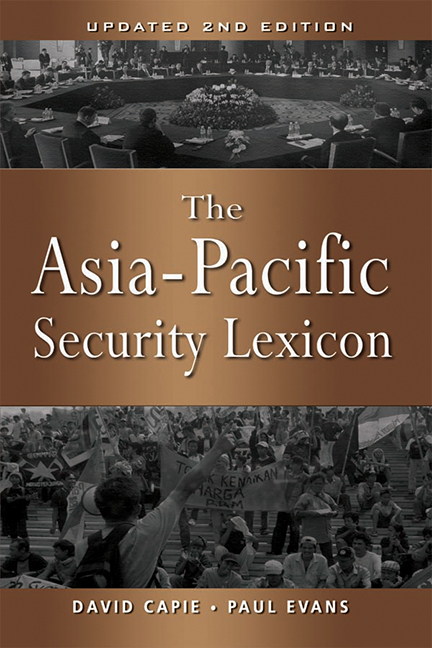Book contents
- Frontmatter
- Contents
- Abbreviations
- Introduction to the Second Edition
- Ad Hoc Multilateralism
- A la Carte Multilateralism
- The “ASEAN Way”
- Balance of Power
- Bilateralism
- Coalition of the Willing
- Coercive Diplomacy
- Collective Defence
- Collective Security
- Common Security
- Comprehensive Security
- Concert of Powers
- Concerted Unilateralism
- Confidence-Building Measures
- Confidence- and Security-Building Measures
- Constructive Intervention
- Cooperative Security
- Engagement
- Flexible Consensus
- Human Security
- Humanitarian Intervention
- Middle Power
- Multilateralism
- Mutual Security
- New Security Approach
- Non-Traditional Security
- Open Regionalism
- Peaceful Rise
- Pre-emption and Preventive War
- Preventive Diplomacy
- Security Community
- Terrorism
- Track One
- Track One-and-a-Half
- Track Two
- Track Three
- Transparency
- Trust-Building Measures
- About the Authors
Humanitarian Intervention
Published online by Cambridge University Press: 21 October 2015
- Frontmatter
- Contents
- Abbreviations
- Introduction to the Second Edition
- Ad Hoc Multilateralism
- A la Carte Multilateralism
- The “ASEAN Way”
- Balance of Power
- Bilateralism
- Coalition of the Willing
- Coercive Diplomacy
- Collective Defence
- Collective Security
- Common Security
- Comprehensive Security
- Concert of Powers
- Concerted Unilateralism
- Confidence-Building Measures
- Confidence- and Security-Building Measures
- Constructive Intervention
- Cooperative Security
- Engagement
- Flexible Consensus
- Human Security
- Humanitarian Intervention
- Middle Power
- Multilateralism
- Mutual Security
- New Security Approach
- Non-Traditional Security
- Open Regionalism
- Peaceful Rise
- Pre-emption and Preventive War
- Preventive Diplomacy
- Security Community
- Terrorism
- Track One
- Track One-and-a-Half
- Track Two
- Track Three
- Transparency
- Trust-Building Measures
- About the Authors
Summary
The idea that in certain circumstances it is permissible under international law for a state or states to use military force to intervene in another state's territory, in order to prevent a humanitarian disaster from taking place, even without the permission of the government of that state. While the idea has developed an extensive literature, it is strongly disputed by some governments. Legal scholars also differ over its scope and substance.
According to Peter Malanczuk, “there are numerous and often conflicting definitions of ‘humanitarian intervention’, some of which appear to be mere de facto ‘working definitions’, and others which are meant to be normative in the sense that the definition itself purports to establish criteria of legality or illegality.” Legal scholar Wil Verwey attempts to find what he calls an “authentic definition” of humanitarian intervention as a legal concept, but concludes “one is immediately confronted with a major analytical obstacle: it soon appears from a comparative analysis of relevant instruments and literature that there may be few concepts in international law today which are as conceptually obscure and legally controversial as ‘humanitarian intervention’.” He attributes this to the lack of consensus on the legal meaning of both the terms intervention and humanitarian.
Sean Murphy uses a working definition which assumes that humanitarian intervention “is the threat or use of force by a state, group of states, or international organization primarily for the purpose of protecting the nationals of the target state from widespread deprivations of internationally recognized human rights”. Baxter emphasizes that the force used must be “short term”. Verwey argues that to be considered as “humanitarian”, forcible action must be “for the sole purpose of preventing or putting a halt to serious violations of fundamental human rights, in particular threats to the life of persons, regardless of their nationality”. His stipulation that it be solely for preventing these violations is so strict that he does not think there have been any genuine examples so far.
- Type
- Chapter
- Information
- The Asia-Pacific Security Lexicon (Upated 2nd Edition) , pp. 145 - 154Publisher: ISEAS–Yusof Ishak InstitutePrint publication year: 2007



